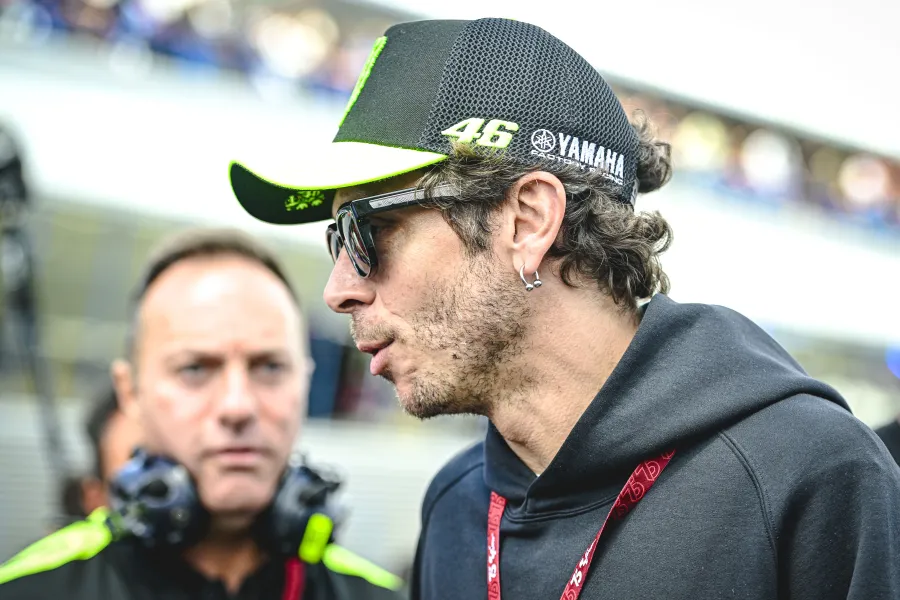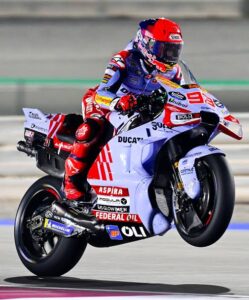
Valentino Rossi, one of MotoGP’s most iconic riders, has never been one to shy away from speaking his mind. Recently, he made a bold statement about the increasing dangers of modern motorcycle racing, suggesting that today’s MotoGP environment is more hazardous than ever. “You hurt yourself more in MotoGP,” Rossi said, sparking debate among fans, experts, and riders alike. But what does this claim really mean? Is it a legitimate concern regarding the sport’s evolution, or merely an exaggerated reaction to the rise of younger, fearless riders like Spain’s Pedro Acosta?
The Changing Nature of MotoGP: Evolution or Danger?
To understand Rossi’s comment, it’s important to consider how the sport has evolved over the years. MotoGP has witnessed technological advancements, changes in bike design, and evolving riding techniques. The introduction of electronics and more powerful engines has made motorcycles faster and more advanced. However, this also means the stakes are higher, and the margin for error smaller.
Gone are the days when riders like Rossi, Mick Doohan, and Kenny Roberts fought on comparatively simpler machines. The current crop of bikes is a blend of cutting-edge technology and raw speed, which, while enabling incredible performances, also comes with an inherent increase in risk. The bikes are quicker, the track conditions more demanding, and the competition more intense. In some ways, these factors could contribute to a perception that MotoGP is becoming a more dangerous sport.
One notable difference between the era of Rossi’s prime and today’s MotoGP is the increased use of electronics like traction control, anti-wheelie systems, and sophisticated telemetry. While these features have enhanced rider safety, they have also allowed younger talents to push the boundaries of speed and technique further than ever before. With these advancements, riders are now required to handle machines that require both extreme precision and bravery.
But is this technology a blessing or a curse? Many argue that while modern tech has made the sport safer in some respects (by controlling engine power and reducing the likelihood of certain crashes), it has also enabled riders to take risks that they wouldn’t have been able to before. In fact, these technological tools can sometimes mask the dangers that still lie beneath the surface, giving riders a false sense of invincibility.
The Rise of Young Talent: Pedro Acosta and the New Generation
On the other side of the argument is the rise of younger, more fearless riders, such as Pedro Acosta, who has quickly become one of the most talked-about names in MotoGP. Acosta, who burst onto the scene with his phenomenal talent, has shown an ability to dominate the competition in a way that very few riders have at such a young age. His aggressive racing style, unyielding confidence, and near-precognitive ability to push the limits of both the bike and the track have earned him both admiration and concern from veterans like Rossi.
Acosta’s meteoric rise raises a pertinent question: Is the sport getting more dangerous because of younger riders pushing the envelope? Rossi’s comment could be interpreted as a critique of the new generation’s approach to racing—where youthful audacity often takes precedence over measured caution. With the likes of Acosta and others challenging the norms of MotoGP, the sport could be entering an era where risk-taking is prioritized, and the line between genius and recklessness becomes increasingly blurred.
It’s not just Acosta who embodies this shift. The current generation of MotoGP riders, many of whom are in their early twenties, approach racing with an intensity and hunger that’s arguably unmatched by their predecessors. These riders grew up with access to more sophisticated training and development tools, such as virtual reality, simulators, and cutting-edge fitness regimens, making them more prepared but also more aggressive. This may be a contributing factor to the increasing number of high-speed crashes and injuries in recent years.
Is Rossi Right to Be Concerned?
Despite all these factors, it’s worth considering whether Rossi’s statement is overly dramatic. The veteran has seen the evolution of the sport firsthand, from its raw, high-risk origins to its current state of technological sophistication. It’s possible that his comment reflects a certain nostalgia for the simpler, yet no less dangerous, days of MotoGP. It’s also possible that, as a rider with a legacy built on calculated risk-taking, Rossi views the current generation’s penchant for pushing boundaries as a form of reckless abandon.
However, one could argue that the perception of increased danger in MotoGP is not necessarily tied to the riders themselves, but to the nature of the sport today. With faster bikes, faster lap times, and a larger global audience demanding ever more spectacular performances, MotoGP has inevitably become more intense. The sport’s commercialization and its expanding media coverage often push riders to perform at the edge of their abilities, heightening both the pressure and the likelihood of serious accidents.
Additionally, modern medical interventions, improved track safety features, and better protective gear have significantly reduced fatalities and life-threatening injuries compared to decades ago. The sport might be more dangerous in some respects, but it is also safer in others.
Conclusion: Is the Sport More Dangerous or Is It Just Perceived That Way?
So, is Valentino Rossi’s claim that “you hurt yourself more in MotoGP” an accurate reflection of a sport that is becoming increasingly hazardous, or is it merely a response to the emergence of a younger, more fearless generation like Pedro Acosta? It’s likely a combination of both.
MotoGP has undoubtedly evolved into a faster, more intense sport, but modern safety measures have kept up with the advancements in technology. While the younger generation is pushing the limits, it’s also important to recognize that the sport is better equipped than ever to handle the risks involved.
At the end of the day, whether MotoGP is more dangerous today than it was in Rossi’s heyday is open to debate. What’s certain is that the sport will continue to evolve, and with it, the risk. The balance between thrill and danger is part of what makes MotoGP so compelling—but whether it is becoming too dangerous for comfort is a question that will continue to be debated as long as there are riders willing to risk it all for glory.






